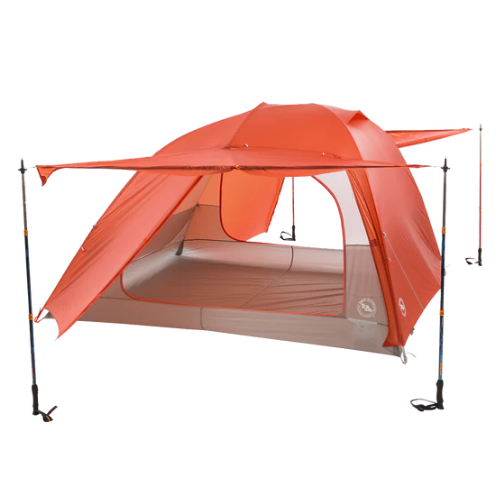Big Agnes Copper Spur HV UL1

Roomy, comfortable shelter with plenty of storage. Generally good weather protection and ventilation. I love this castle of a tent.
Pros
- Fairly light
- Good stakes
- Good storage and room
- Good ventilation
- Good weather protection
Cons
- Needs a guyout tab at the foot end.
- .Fabric can sag in the cold
- Eyebrow poles cause "sag furrows" which can catch water if the "pockets" are used.
- Top center section is relatively flat, catching snow, etc.
I have used this tent on multiple trips in the Virginia Blue Ridge mountains as well as in the Bridger Wilderness in Wyoming. This review is based on those trips and particularly on an 8-day backpacking loop trip in Wyoming mountains with elevations around 10K.
In two very hard thunderstorms the waterproofing of the fabric was overwhelmed, allowing moisture to "spritz" into the interior. I had previously seam sealed the tent, but had not used overall waterproofing, which I will now do.
The two "eyebrow" poles at the top middle of the tent do not, in my opinion, have enough angle, which creates a nearly flat section of roof, preventing efficient sloughing off of snow, frost, or rain. Not putting those short poles in the reinforced pockets seems to allow the upper roof to have a smoother shape without furrows, which helps to shed rain.
While there are two tabs for guyout lines at the head end, there are none at the foot end. The foot end is more "aerodynamically" designed to withstand wind, but one tab would be useful, both for stability and to provide an attachment point so that reflective lines could be joined over the top of the tent to make it more visible when returning to the tent late in the day or at night.
Because of the nature of the fabric (not just on this tent, but most tents using this fabric), cooler temperatures at night can cause the tent walls, particularly the vestibule, to sag. This can be offset by using a length or loop of very thin bungee cord as a shock absorber which helps maintain tautness.
The side heights and the ventilation port on the head end provide good ventilation, and the ventilation port is positioned so that the entry of rain is not a problem except possibly in the hardest winds. A mesh section is used on the inside of the port and while this helps keep out mist, if this were left off, one could reach through the inner door to open or close the port without having to go outside the tent. Maintaining good ventilation is important by not staking the sides out too low.
One night when camped on grass cold temperatures caused the interior surface of the tent walls to become coated in ice and frost, because I tried to pull sides down to hold heat better. Pro—Because this is double walled, one can simply take the exterior walls off and shake off the ice. My companion in a single wall tent did not have this option.
Background
I have owned three BA tents (two Copper Spur, one Seedhouse), Marmot, REI Quarter Dome and others. The Copper Spur is my favorite and I love it.
Source: bought it new
Price Paid: Don't remember. Backcountry Gear dot com
Your Review
Where to Buy
You May Like
Specs
| Price |
MSRP: $379.95 Current Retail: $52.50-$549.95 Historic Range: $52.50-$549.95 |
| Trail Weight |
2 lb 2 oz / 964 g |
| Packed Weight |
2 lb 6 oz / 1.08 kg |
| Fast Fly Weight |
1 lb 10 oz / 737 g |
| Packed Size |
17.5 x 5.5 in / 44 x 14cm |
| Floor Area |
20 sq ft / 1.9 sq m |
| Head Height |
38 in / 97cm |
| Vestibule Area |
9 sq ft / 0.8 sq m |
| Footprint Weight |
4 oz / 113 g |
| Number of Seasons |
3 |
| Number of Doors |
1 |


